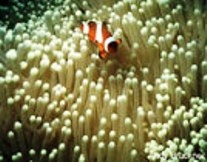 |
| "Clown fish live symbiotically with sea anemones. Photo credit: Andy Bruckner." |
Coral Reefs
In addition to being one of the earth's most beautiful, colorful, vibrant, and oldest ecosystems, coral reefs serve a variety of helpful functions. Found in the clear, warm, shallow waters of tropical oceans around the world, they are incredibly diverse and productive.
Coral reefs aid in the protection of various forms of marine life, providing food and shelter to fish and invertebrates, and thus helping sustain biodiversity. They are home to 1 million species; clown fish, sea anemones, lobsters, sea turtles, seahorses, sponges, and thousands of other species call coral reef systems home.
They also serve as natural buffers against storm surges, flooding, and waves and help stop shore erosion, thus protecting coastlines and the lives and property of their inhabitants.
Thousands of communities around the world also depend on coral reefs for food, protection and economy. Reefs provide jobs both through fisheries and through tourism and recreation, such as diving tours and recreational fishing.
Coral reef plants and animals are also important to modern medicine. New medicines and treatments stemming from coral reefs are being developed to treat cancer, arthritis, bacterial infections, heart disease, viruses, and more, in addition to pain killers, nutritional supplements, and even commercial products.
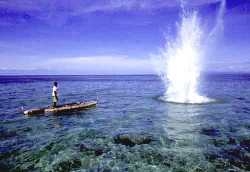 |
| Destructive dynamite fishing |
Reefs in Danger
Yet for an ecosystem resilient enough to have survived millions of years, it is also a sensitive one, and unfortunately, at great risk from a variety of natural and human threats. Weather (like hurricanes and tsunamis), pollution, global warming, dynamite fishing, and over-fishing are all contributing to the demise of these beautiful, but highly-endangered ecosystems.
Coral reefs are diminishing at alarming rates worldwide. Currently 16% are damaged, and another 11% have already been lost, and scientists believe that more than another 30% of them will be lost within the next three decades if they continue to decrease at this rate!
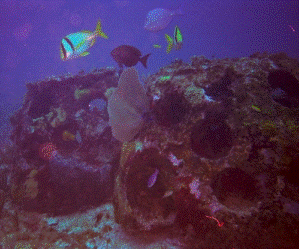 |
| Cancun Reef Balls (photo courtesy of the Reef Ball Foundation) |
The Reef Ball Foundation
The Reef Ball Foundation strives to protect natural reef systems and to restore the world's ocean ecosystems.
They do so by using innovative earth-friendly technology. Their projects include the Reef Ball, an artificial reef that promotes reef rehabilitation, estuary restoration, coral propagation, and public and private education. Their educational projects help raise awareness of the earth's vital need for healthy coral reef systems: why they are important, and why they need to be preserved.
Reef Balls are made of special concrete that mimics the appearance and function of natural coral reefs. They promote coral reef regrowth, assist in coral and marine habitat restoration, and are "also used to protect beaches and to help with oyster recovery in bays and estuaries."
The Reef Ball Foundation's Reef Ball technology has garnered worldwide acclaim. So far they have put Reef Balls to use in over 50 countries, in addition to creating educational projects in 14 countries.
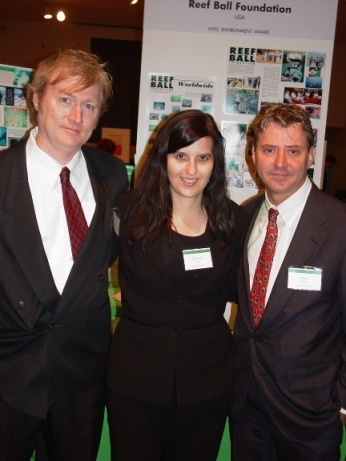 |
| L-R: Doug Hollingsworth, Katherine Kirbo, and Todd Barber. |
Todd Barber on the Reef Ball Foundation:
The Reef Ball Foundation is a company that restores coral reef systems. We go around the world. We've done 3500 reefs that we've rebuilt by using a concrete and artificial reef module that we put in the ocean. We plant corals on top of them, and they grow into a natural coral reef. We've done this in 50 countries and we've done over half a million Reef Balls around the world. It's our mission to restore the corals that have been damaged by man's activities.
Katherine Kirbo, Director of the Reef Ball Foundation, speaks on the importance of marine education:
Education is very important to us and Reef Ball is a great educational tool to teach kids, and adults, about the importance of the ocean ecosystem. It's a great hands-on project for kids. Basically, kids will help build the reef balls, [and] learn about marine biology. For example, one educational project [is] one in Jacksonville, Florida, in St. Augustine where all the schools in the area had a competition about who could build the most reef balls. They deployed them off the coast of Jacksonville, after the project was completed. They kids learned about oceanography, marine biology, reef ball construction, how to get permits and grants to do the project, and how to deploy them. The university donated scientists and boats, and community organizations [pitched in too]. It's a very comprehensive, educational project.
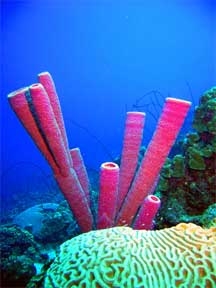 |
| Purple Tube Sponges (photo courtesy of Jim Dean) |
Doug Hollingsworth, Director, gives a simple synopsis of how the project works:
Reef Balls go anywhere from [one about the size of a basketball] to up to about the size of a car. We go around and drop the Reef Balls in the ocean and all the little things that grow down there want to grow on them. All the corals, the sponges,and the sea squirts, and everything else want to grow on on the Reef Balls because of the way they are made. That way, we get a coral reef growing really fast. We've got everything that wants to be on a coral reef growing on the Reef Balls, and the fish move in right away. As soon as the Reef Balls hit the bottom, 'bam!' fish move inside, and the other stuff begins to grow on them.
And we also take broken coral that has been hurt in storms, and things like that; we can pick it up and plant it on the outside of the Reef Ball. That way we not only save the broken coral that would have died otherwise, but we also help to get the whole reef going. We have volunteers that go all over the world. They dive and get in the water and get dirty and wet, and work real hard. They swim around and collect the stuff and put the Reef Balls in the water and that's how we help save the reefs that are dying all over the place and being hurt. We help to keep them alive.
Is there a particular area you are currently concentrating on?
We are working in different countries around the world, but lately we have been concentrating a lot in tsunami-affected regions, and the Atlantic basin where the hurricanes have been really, really strong this year. We tend to work in places where there has been damage to the reef from either natural disasters or sometimes it's from a shipwreck or grounding, or it can be the activities of man such as pollution or fertilizer runoff or various other types of activities that can damage coral reefs.
Who are your heroes?
Todd Barber: My heroes include Albert Thiel and Martin Moe who were some of the early pioneers of the aquarium industry that developed the techniques for growing and cultivating corals.
Kathy Kirbo: Thomas Jefferson is my hero because he was so diverse and a Renaissance man. He was talented as a writer, a lawyer, historian, inventor, and musician, and he had a great knowledge of art.He could do just about anything.
Doug Hollingsworth My heroes are Jacques Cousteau, Johnny Cash, and Martin Luther King. Johnny Cash was a great man who wrote some good songs and cared about people. Jacques Cousteau -- I just wanted to work for him when I was a kid. He was in the ocean all the time and that's where I wanted to be. And Martin Luther King helped bring everyone together, and that's what I think we should all be doing.
Page created on 8/17/2014 9:55:59 AM
Last edited 1/9/2017 11:03:11 PM
